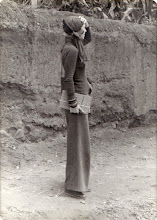For the artist generation between the 1940s and the early 1960s, AbEx meant a new, cumulative kind of self-awareness, rejecting the prescriptive views of art instructed by its historical narrative. Moving away from the realist modes and confronting the emotional disconnect of European post-Cubist Abstraction, they developed a painterly critique of painting itself. The physical expression of the artist’s subjective vision of painting itself was considered an aesthetic possibility for the exaltation of the medium itself, that is, for artists who considered themselves still a part of the history, or narrative, of art. Celebrated it its primal masculinity, but also in its negation of illusionistic modes and base political distractions, Abstract Expressionists such as Pollock harnessed the deep unease, tensions and censorship felt in Cold War times to express what Greenberg called an “elevated subject matter”. Adolph Gottlieb and Rothko denied that their paintings were “about nothing. We assert that only that subject matter is valid which is tragic and timeless.” Though if the “coming of age” of the art history narrative, according to Arthur Danto, should “be extremely vigorous and show no sign whatever of internal exhaustion”, they why did Rothko consciously promote the sublimity of his work by intervening in his exhibition spaces and writing letters to the New York Times in his defense? (Rothko Room) By scaling his paintings to envelope the viewer and eventually moving to muralism itself (Seagram Murals )? Why do curators struggle to keep showing his work as more than a sea of beautifully hued atmospheres? Jeffrey Weiss at NGA
The distractions, if not the pomp, of exhibiting techniques were stripped away, paralleling what Greenberg prescribed as a search for ‘purity’ and an ‘independence from art’ that entailed seeing a “Modernist picture as a picture first”. When the subject was no longer visually representational and the canvas no longer simply a window or a mirror illusionistically referencing those strolling the gallery floors, then the importance of the painting’s self-defining surface placed it at a level and in a space where it could directly engage and confront the viewer and their conception of what they should be seeing. The implied extension of the picture plane beyond the frame, or eventually beyond the edges of the stretcher, onto the walls, meant forcing the works further and further apart; far from leaving ‘neutral’ space between paintings, this allowed for its power to radiate outside its surface and for the philosophies it engaged to muse without any radial clouding or associations.
How could the apparent cumulation of a teleological narrative not be well-received by the art world, who had appropriated and guaranteed the terms of its own reproduction over the course of so many different movements, only to find that they were all talking about the same thing: painting itself? Modernism, according to Danto, was the self-affirmation after so many “mishaps and misplaced enthusiasms”, looking inwards, and finding each artist’s abstract self-portrait. But was art of the 40s, 50s and 60s the the declaration of independence before the happily ever after? For Danto, it is hardly so. If anything is an indication of an imminent loss of vigor in the art history narrative, it is the explosion of media and the “loss of faith”, that followed with Contemporary Art's answer to "the end of art". This is interestingly illustrated for example by the rise of the museum as a medium: the felt need to reorganize and reconsider not just style, subject and medium of past works but also incorporating the otherwise invisible struggles embodied by/in the institution.
Mining the Museum, Fred Wilson
Judith Stein on Fred Wilson's Mining the Museum at the Maryland Historical Society
Note also the museum itself as an artistic agent: The Contemporary in Baltimore, taking the museum itself to new places (bus stations, car dealerships, etc).

Aucun commentaire:
Enregistrer un commentaire